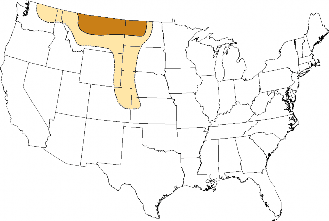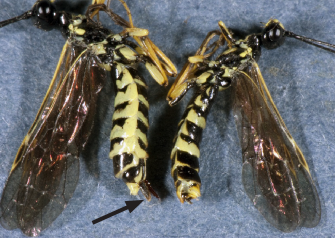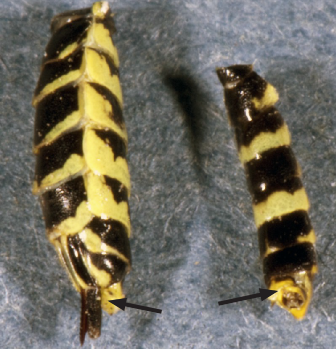
Wheat Stem Sawfly Biology
This Montguide provides background on the wheat stem sawfly, Cephus cinctus Norton, its history, distribution and aspects of its biology that make it a serious pest.
Last Updated: 05/17by Jesse Fulbright, MSU Extension Agent, Liberty County; Kevin Wanner, MSU Cropland Extension Entomologist; Anton Bekkerman, Associate Professor, Agricultural Economics; and David Weaver, Associate Professor of Entomology, Department of Land Resources and Environmental Sciences
Origin and distribution
The wheat stem sawfly, Cephus Cintus Norton, is the most costly insect pest of Montana wheat production. Between 2010 and 2014, Montana's state-wide winter and spring wheat losses related to the wheat stem sawfly were estimated to be $52.2-$80.0 million annually. In areas with particularly serious infestations, spring wheat producers could lose up to $75,000 for an average sized farm, and winter wheat farmers could experience losses up to $120,000.

Figure 1. Adult female wheat stem sawfly.
The wheat stem sawfly was originally found in native prairie grasses. It was first reported and described from a sample collected in Colorado in 1872, and was in 1895 in Manitoba. It has been suggested that the wheat stem sawfly was recently introduced to North America from northeastern Asia. However, early records indicate that wheat stem sawfly occurred in large stem native prairie grasses such as western wheat grass and basin wildrye as well as other wheatgrasses of the genus Agropyron. Early predictions about the wheat stem sawfly by scientists stated, “it may be expected at any time to abandon its natural food plant in favor of the small grains.”
There are 25 to 30 species in the genus Cephus worldwide. Two species are found in North America, Cephus cinctus, in the western U.S. and Canada, and Cephus pygmaeus (L.) in the eastern U.S. and Canada. However, only Cephus cinctus causes large economic losses in North American wheat crops at this time. Cephus pygmaeus is no longer an economically important pest due to the introduction and establishment of parasitoid wasps in the 1930s.
With the introduction of wheat and other small grains, the host range of the wheat stem sawfly expanded and wheat was found to be a viable and easily accessible host. The first report of damage in wheat by this insect was reported in Manitoba in 1895. Spring wheat was the primary cereal grain impacted by this pest but it has subsequently infested and severely affected winter wheat as well. With an increase of winter wheat acreage, losses due to damage became more apparent, beginning in mid-1980s.
Areas with historically high risk of damage due to wheat stem sawfly include the states of Montana and North Dakota, as well as the Canadian provinces of Alberta, Saskatchewan and Manitoba. In recent years, losses from damaging populations have also been reported in parts of South Dakota, Wyoming, Idaho, northwest Kansas, eastern Colorado, western Nebraska and the Columbia Basin and Palouse regions of Washington State.
Wheat stem sawfly biology
Adults of both sexes are reported to be weak fliers and rarely fly long distances at one time. However, recent indications are that they will move as far as they need to, up to several miles from their site of origin. When resting on a plant stem, the adult is normally found with its head downward and its legs aligned with its body. Adults are thought to feed on droplet moisture from leaves and on nectar.

FIGURE 2. Region where the wheat stem sawfly has historically posed the greatest risk to wheat production in the Northern Great Plains (Map modified by Kendra Grams and Sheila Torgunrud, Agriculture and Agri-Foods Canada, Lethbridge, Alberta)
The life span of the adult requires that the life cycle is synchronized with the phenological development of the host plant. All the developmental stages of the insect occur within the host plant, except the adult stage.
This species only has one generation per year. Adults are active during warm conditions when temperatures exceed 62°F and wind speeds are minimal. Activity declines during cloudy, windy, or rainy conditions. The life span of an adult varies between five and eight days, and adults normally emerge from May to July, with the emergence usually lasting three to four weeks. Adult males emerge before females, ensuring that most of the early females will be mated and that most of the eggs oviposited in the early part of the adult flight will be fertilized, while most of the eggs deposited near the end of the flight period will be unfertilized. Unfertilized eggs produce males with one set of chromosomes (haploid), while fertilized eggs produce females with two sets of chromosomes (diploid). The emerging adults are sexually mature and ready for copulation and oviposition. Adult females lay 30 to 50 eggs in a lifetime.

FIGURE 3. Fully grown larva of the wheat stem sawfly.
The egg stage of the sawfly is five to seven days in length. Larval development of the sawfly includes multiple stages and will last for about one month. What happens during the larval stage is of primary importance. Feeding begins as soon as larval mouthparts harden and are capable of chewing. The larvae begin feeding near the oviposition site, eventually feeding up and down the stem, chewing through nodes, as in Figure 3. As the larva feeds, it fills the stem with excreted plant tissue called frass, which is visible by splitting the stem open. The larvae are cannibalistic, so although several eggs can potentially be placed in a stem, only one adult will emerge the next year.
As host plants mature and dry, the larva descends toward the base of the stem to prepare for a period of dormancy called diapause. The larva chews around the inside of the stem, creating a “v”-shaped groove and cutting almost through the stem tissue. This larval girdling is initiated when the stem moisture decreases and the moisture content of the kernel reaches 41 to 51 percent. After this injury to the stem is done, it will probably break due to wind and gravity. The area directly below the girdled site is then plugged with frass to prevent the remaining stem from bending, or breaking, which would adversely affect the larva. The larva then constructs a thin, cellophane-like sac within the stem to protect it from desiccation and excessive moisture.

FIGURE 4. Wheat stem sawfly adult pair

FIGURE 5. Wheat stems where the wheat stem sawfly has not emerged (left) and emerged (right).
Pupal development occurs after a required period of cold temperature. This development may vary according to climatic and environmental conditions. The pupa is pale white. As pupal development progresses, wings develop and pigmentation of the body occurs, resulting in a fully formed adult. The insect overwinters below the soil surface in a cutoff stem as a prepupa. Upon completing pupation, the adult will chew through the frass plug and emerge, as illustrated in Figure 5. Ideal conditions for emergence and infestation are a warm moist May with sufficient moisture for plant growth and a hot June with dry weather for flight.
The wheat stem sawfly has adapted to wheat cultivation. As an example, it now emerges 21 days earlier than indicated in historic records, due to the increased planting of winter wheat. A second example are reports of damaging populations in areas beyond its historic range, as described above. Also, while wheat is still the primary host in Montana, there are increasing reports of damaging populations in barley.
Plant susceptibility
One of the more important factors in the selection of the oviposition site is the stage of plant growth. Females prefer the more tender part of the internode. Early in the oviposition period, the females will select elongating stems to infest. As the stems reach their full length and maturity, the female will select the less mature stems or tillers. Usually females oviposit in the second to last developing internode and as the stem grows, eggs are laid in progressively higher internodes.

FIGURE 6. Abdomen comparison of female sawfly (left) and male sawfly (right), noting size differences between the sexes and ovipositor present on the female.
The diameter of the stem is also another important factor. In general, large stems are preferred over the more slender stems. Adults emerging from larger stems are heavier, live longer, and have larger egg loads. The infested stems that are larger have a greater seed output and yield potential, which amplifies the negative economic impact of these insects on their host crop plants.
Plants are vulnerable to infestation only after stem elongation has begun and before grains begin to dry. Feeding by the larvae within the stem also reduces the number of kernels and the weight of those kernels in an individual head, probably because it affects the flow of nutrients to the developing head. Feeding by the larvae at the stem node interrupts the upward and downward transport of carbohydrates, resulting in dark areas visible on the stem exterior. Based on this visual cue, infestations can be determined as early as the soft dough stage. However, dark areas may occur in response to plant pathogens, so this characteristic may not always hold true.
Varieties of wheat that are tall and remain green longer are preferred. This does not indicate, however, that the insect will not attack other varieties nearby. The wheat stem sawfly continues to be a major pest in the state of Montana, as it has for more than one hundred years. Future Montguides will detail control measures which will help assist growers in managing damage more successfully. These measures include the use of natural enemies, trap crops, cultural control measures – including forage production – as well as continuing research regarding host plant resistance.

FIGURE 7. A close-up, comparing female (left) and male (right) reproductive structures, noting the ovipositor on the female and the typically retracted reproductive structures of the male.

